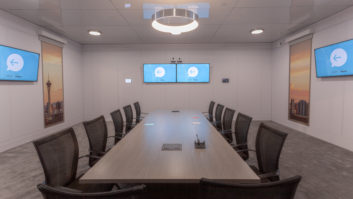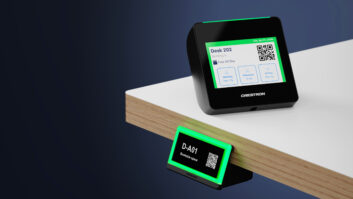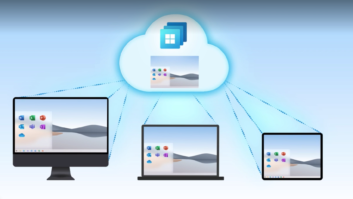 The transition to hybrid meetings has given employees a convenient and necessary way to split their time between locations. Whether you’re working in the office from time to time, or completely remote, it’s important that everyone has a seamless experience. As hybrid working evolves into the new normal, meetings and activities have moved to communication and collaboration platforms. With the introduction of new UK government plans, workers can request hybrid working as part of their contract resulting in more flexible arrangements for millions in the hybrid working world.
The transition to hybrid meetings has given employees a convenient and necessary way to split their time between locations. Whether you’re working in the office from time to time, or completely remote, it’s important that everyone has a seamless experience. As hybrid working evolves into the new normal, meetings and activities have moved to communication and collaboration platforms. With the introduction of new UK government plans, workers can request hybrid working as part of their contract resulting in more flexible arrangements for millions in the hybrid working world.
Businesses must ensure that they have strong priorities in place to adopt the necessary technologies to support their employees. Video meetings and content sharing continue to be an essential point of contact between colleagues, partners, and clients. But what are the key tools, technologies and IT infrastructure that organisations should consider for employees to interact with?
Getting the right equipment and set-up for hybrid meetings is important. As a minimum, remote users need high quality cameras, microphones, speakers or headsets to ensure they can be seen and heard clearly in the meeting. These devices should utilise AI technologies that remove unwanted and distracting background noises. The key is to make remote workers feel involved and not merely an onlooker in the meeting room else they will be less engaged. They need to interact and share content with the same experience as if they were in the room, so organisations must invest in the right tools to achieve this.
When it comes to the in-room experience there are different types of meeting spaces. For example, huddle spaces that seat a handful of people in one area, small group rooms of up to 10 people and then larger rooms or auditoriums that can accommodate 20 to 30 people and more. Across all these room types there are three factors that need to be considered:
Reliability is key
Whatever the meeting space the user experience must remain consistent. It must be as easy to use a large boardroom system as it is a single-person endpoint. From how you start and end a meeting, the control interfaces you use and the way in which you share content and use collaboration tools, familiarity is key. This may mean investment or it could be that you choose to align with a company standard such as Webex, Microsoft Teams or Zoom. Too much variation between rooms will lead to underutilisation of meeting spaces.
Digitally advanced rooms
This means looking beyond how the system is used in the room. It concerns how users book the physical and virtual space beforehand. Organisations need to have effective room booking systems in place which use visual indicators to allow people to see room availability at a glance. This can mean integration with calendaring systems and making use of room booking panels, enabling users to book the room on an ad hoc basis as well as on their mobile and through email. Furthermore, large offices should use digital signage and wayfinding to ensure users can find the meeting room easily.
Clarity
In an ideal world, organisations with large numbers of geographically distributed meeting rooms should be able to centrally monitor their estate from a single pane of glass. These solutions not only enable organisations to maintain the uptime of their meeting spaces, they also utilise people counting tools to help adhere to health and safety requirements concerning maximum occupancy of the room. Furthermore, monitoring solutions help organisations measure environmental factors to ensure staff welfare, track sustainability efforts, allowing them to release rooms when participants don’t show up; reducing energy waste or improving efficiencies by enabling others to use the vacant space.
The ability to network
The shift to hybrid working not only introduces the challenge of how to connect remote participants and allow them to work from anywhere, but how to do so securely. It concerns optimum ways to connect users to the public cloud services where meetings are being hosted, where using local Internet connectivity is often better than connecting them back to and via the head office or data centre.
Some office spaces were fundamentally designed for in room meetings. There is now a need for remote users to take part. Here connectivity and configuration need to be considered. Moving employees beyond the office firewall requires a rethink of networks. Organisations must look to protect their expanding network boundary to enable users to connect to a secure system to access files and applications. This means added consideration for your security, remote access and firewall traversal policies and technologies.
With more technology being introduced to enhance hybrid meetings, organisations will need to be mindful of maintenance. This is where cloud registered systems and managed services can support dynamic updating of software and features. When it comes to the rooms themselves the emphasis is on flexibility and adherence to your long-term strategy. Organisations must understand how their rooms are being used and at what frequency. Cloud based monitoring tools can provide this analytical insight and enable organisations to optimise the use of their meeting spaces. They must consider what collaboration platform is being used and if this has the ability to connect with other conferencing software when teams need to connect with customers or partners.
To conclude, organisations need to decide on the most appropriate applications to suit their needs and make sure that services are compatible with one another. A combination of security and accessibility will help to deliver hybrid workers with a more secure and engaging experience in the long term.







